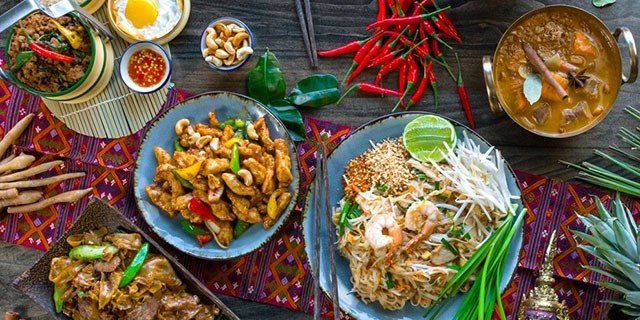Thai Cuisine
Introduction
Since the explosion in tourism to Thailand in the 1980’s Thai food has established a foothold as one of the world’s leading schools of the culinary arts. It is one of the 5 most popular food types globally, the others being Indian, Chinese, French, and Italian. When you visit Thailand, although it is possible to enjoy western food, why bother? You are in the home of one of the world’s great cooking schools, so sit back and enjoy.
History and Origins
Thai food originated with the people who emigrated from the southern Chinese provinces into modern day Thailand many centuries ago. Historically there were many Szechwan influences in Thai cuisine, although over the centuries many other influences have affected Thai food. In a more distant past, Buddhist monk brought an Indian touch, and southern Muslim states influenced the cooking in the south of Thailand. Much later, Thai food was influenced by European cuisine after contact with Portuguese missionaries and Dutch traders. During these times there were even some influences from the Japanese. Today Thai food is its own, with a special unique blend of the 5 tastes: sweet, sour, bitter, salty, and spicy.
Regional Differences
Thailand is a big country with a diverse geography, and over the years this has led to the development of regional differences in its style of cuisines. Currently there are 4 distinct styles of cooking in Thailand.
Northern
The cooking in northern Thailand is generally milder than in the rest of the country, sticky rice is preferred, traditionally it is kneaded into small balls with the fingers. There is a strong influence from neighbouring Burma with popular dishes like Kaeng Hang Le, a pork curry flavored with ginger, turmeric, and tamarind.
North-eastern
The food in the north east is influenced by Laos; as a general rule the food is highly spiced, and sticky glutinous rice is the preferred staple for north-eastern dishes. Although there are plenty of meat dishes, historically meat was scarce in the villages, and the main source of protein were shrimp and freshwater fish. These were often fermented to increase their shelf life.
Central
The central region offers cuisine that is midway between the north and south, although fragrant Jasmine rice is preferred to the sticky variety. What makes the central region cuisine special is that it is home to royal cuisine. This type of cooking which originated in the royal palace involves much more elaborate meals, put together with complex techniques. It is more of an art form than just regular cooking.
Southern
Southern Thai cooking is the most popular outside of Thailand since that is the main tourist region of the country. In southern cuisine there is much more use of coconut milk in many dishes. Coconut replaces Ghee for frying and there is a heavy use of seafood in the dishes. Appetizers in the south use a lot of cashews from local plantations, and coconut flesh as a standard condiment.
Thai Curries
Thai curries are identified by their color. There are four main colors: green, red, yellow, and orange. Counter-intuitively, the hottest of them is the green curry followed by the red, the yellow which is the Thai version of an Indian curry, and the mildest is the simple orange curry. In addition to the basic color curries, there are two other curries that ae immensely popular: Panang and Massaman. They originate in the south of Thailand, with Malay and even Persian influences. They have a much thicker sauce than traditional Thai curries.
Thai Food in Khao LakYou are spoiled for choice when it comes to food in Khao Lak, with over 200 restaurants and chefs from all over the world, you can find food of a great variety of food choices. However, what makes the Thai food truly excellent in the area is the sheer freshness of the ingredients. Unlike some of the international cuisine on offer the Thai food ingredients do not travel far. Seafood comes from the sea and the vegetables and meat from many of the farms and local plantations nearby. This freshness gives Thai food in Khao Lak its own unique flavor and richness.
I heard Thai food used to be hotter and spicier?
Funnily enough yes, historically the Thai people were very good at “Siam sing” foreign culinary influences. In fact, chili didn’t exist in Thai cuisine until the 16 hundreds, when they were brought over by Portuguese missionaries, who had acquired a taste for them during their forays in South America. As a result, the Thais used more and more heavy spices and the food became hotter and hotter. In more recent times there has been a shift in Thai cooking style with less and less use of heavy spice mixes, and the increase in use of fresh herbs such as lemon grass in most dishes. So yes, over the years Thai food has got less spicy and more herb flavored.
How do Thai Curries differ from other south Asian curries?
Generally, since Thai cuisine uses a lot of coconut milk, Thai curries are much more liquid than those of India for example. Furthermore, with a tradition of mixing ingredients Thai curries use a lot of vegetables, even in meat dishes, so unlike other south Asian curries where the meat curry is separate to the vegetable dishes, in Thailand the meat curry will also contain a good amount of vegetables. The final difference in Thai curries is how spices are used; most Thai cuisine uses spices in a paste form. This use of paste reduces cooking times in comparison to Indian curries – since the spices are precooked. It also offers a more enhanced flavor since the spices have had a time to marinate and mature together.
How are Thai dishes classified?
Thai food is generally classified into 4 types; rice dishes which vary from region to region, with the north and north-eastern regions preferring the sticky variety of rice and central Thailand preferring the more fragrant variety. Then comes side dishes, this is quite a big grouping since it includes curries, soups, stir fry’s, salads, dips, and accompanying dishes known as “naem”. Desserts are the third category in Thai foods, they are usually made of rice flour, sugar, and coconut. Although sweet potato, taro, and water chestnut are added to some desserts. Finally comes plate meals, these will have a mix of a meat, vegetables and fried noodles or Thai fried rice.
What is Thai food etiquette?
Thailand, like many countries, has its own cultural nuances when it comes to food. If you have dinner with a Thai family, there are few things to do that will show your appreciation of Thai culture. Firstly, you should start your meal with a spoonful of plain rice on its own, this emphasizes the importance of rice in Thai culture. Secondly you should only take a few spoonful’s at a time from the serving dishes and make sure to leave some food in the dishes and on your plate. This emphasizes the generosity of your host. Unless you are offered them, do not ask for chop sticks use a spoon and fork for white rice. In the north use your right hand for sticky white rice!


